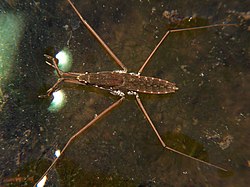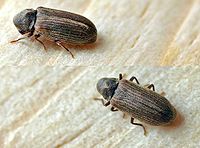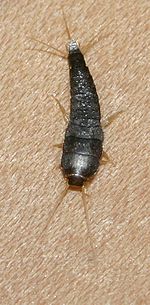Difference between revisions of "AY Honors/Insects - Advanced/Answer Key/es"
(Created page with "{{clear}}") |
(Created page with "{{clear}}") |
||
| Line 123: | Line 123: | ||
{{clear}} | {{clear}} | ||
| − | + | {{clear}} | |
<noinclude></noinclude> | <noinclude></noinclude> | ||
Revision as of 20:37, 25 February 2021
| Insectos - Avanzado | ||
|---|---|---|
| Asociación General
|
Destreza: 2 Año de introducción: 1949 |
|
Requisitos
|
La especialidad de Insectos - Avanzado es un componente de la Maestría Naturaleza. |
|
La especialidad de Insectos - Avanzado es un componente de la Maestría Zoología. |
1
Para consejos e instrucciones, véase Insectos.
2
- a. Añadir a su colección 50 especies de insectos que representen al menos 10 diferentes órdenes. Las etiquetas deben incluir el nombre del colector, fecha, localidad, el orden, la familia, género y nivel de especie o nombre. (Especímenes montados con descuido y rotas no serán aceptables).
- b. Añadir a sus dibujos a color o pinturas 50 especies de insectos que representen al menos 10 diferentes órdenes. Dibujos o pinturas deben ser del tamaño real o más grande, para mostrar los detalles de los pequeños insectos, y en colores naturales. Colocar una etiqueta a los dibujos con la fecha, orden, familia, género y el nombre del nivel de especie.
- c. Añadir a sus imágenes de color 50 especies de insectos que representen al menos 10 diferentes órdenes. Todas las imágenes deben estar enfocadas, en primer plano y debidamente etiquetadas, indicando dónde fue fotografiado, fecha de la fotografía, nombres comunes y cada género o nombre del nivel de especie.
3
4
Bees
Eggs are laid singly in a cell in a wax honeycomb, produced and shaped by the worker bees. Larvae are initially fed with royal jelly produced by worker bees, later switching to honey and pollen. The exception is a larva fed solely on royal jelly, which will develop into a queen bee. The larva undergoes several moltings before spinning a cocoon within the cell, and pupating. Drones hatch from unfertilized eggs, females (Queens and worker bees) hatch from fertilized eggs. The queen actually can choose to fertilize the egg she is laying, usually depending on what cell she is laying in.
5
Social insects, such as the termites, ants and many bees and wasps, live together in large well-organized colonies that may be so tightly integrated and genetically similar that the colonies of some species are sometimes considered superorganisms.
6
| Mosquito | Flea | Louse | Housefly | Tsetse fly |
|---|---|---|---|---|
|
|
|
|
|
7
7a
7b
It is used for sweeping along at ground level through an open field. It is made the same way as the aerial net described above, except that an old pillowcase should be used instead of netting.
7c
An aquatic net can be made by attaching a kitchen strainer to a broomstick with hose clamps. Unless you are using your very own strainer, get permission from its owner (and from the person who uses it the most)! You will quickly learn that using your mother's (or your wife's) kitchen strainer to catch bugs will not earn you any points with her!
To use the aquatic net, submerge it just beneath the surface of the water with the opening facing up. Wait until an aquatic insect swims over the opening, and then quickly lift.
8
An easy way to trap night-flying insects is to suspend a white bedsheet vertically next to a light bulb. Be careful that the bulb does not touch the sheet, as this would be a fire hazard. If possible, use a light bulb that emits ultra-violet light (but be careful to not look at the lit bulb as it can cause eye damage). The insects will be attracted to the light and land on the sheet. They can be picked off by hand.
You can also suspend a light bulb over a pan filled with water and a few drops of dish soap. The dish soap breaks the surface tension on the water so that the insects sink and drown (rather than walking on the surface). Such a trap can be left overnight.
9
9a
i
The family Gerridae contains insects commonly known as water striders, water bugs, magic bugs, pond skaters, skaters, skimmers, water scooters, water skaters, water skeeters, water skimmers or water skippers. These are predatory insects which rely on surface tension to walk on top of water. They live on the surface of ponds, slow streams, marshes, and other quiet waters. They can move very quickly, up to 1.5 m/s.
ii
The horse chestnut leaf miner (Cameraria ohridella or Cameraria operculella) is a moth of the lepidopteran family Gracillariidae. The Horse Chestnut Leaf Miner was first observed in Macedonia in northern Greece in the late 1970's, and was described as a new species in 1986. The moth grows up to 5 mm long and has shiny, bright brown forewings with thin black and white stripes. Its larvae are leaf miners on the Common Horse-chestnut (Aesculus hippocastanum), causing significant damage to the appearance of the trees. Despite the poor appearance of horse-chestnut trees infested with C. ohridella, there is no evidence that damage by the moth leads to a decline in tree health, the development of dieback, or tree death. Trees survive repeated infestations and re-flush normally in the following year. It appears that most of the damage caused by the moth occurs too late in the growing season to greatly affect tree performance. Consequently, there is no reason to fell and remove trees just because they are attacked by C. ohridella.
iii
The tortrix moth Tortrix viridana is known as the European oak leafroller and the green oak moth. It is a distinctive green moth whose larvae feed on tree leaves, especially oak.
An infestation of the larvae can defoliate an oak tree. The adult female lays its eggs next to leaf buds which the larvae consume when they emerge. As the larvae grow bigger they eat larger leaves, and then roll themselves up in a full-sized leaf to pupate.
iv
The common furniture beetle (Anobium punctatum) is a woodboring beetle. In the larval stage it bores on wood and feeds upon it. Adult Anobium punctatum measure 2.7–4.5 mm in length.
Adults do not feed, they just reproduce. The female lays her eggs into cracks in wood or inside old exit holes, if available. The eggs hatch after some three weeks, each producing a 1 mm long, creamy white, C-shaped larva. For three to four years the larvae bore semi-randomly through timber, following and eating the starchy part of the wood grain, and grow up to 7 mm. They come nearer to the wood surface when ready to pupate. They excavate small spaces just under the wood surface and take up to eight weeks to pupate. The adults then break through to the surface as adults, making a 1mm to 1.5 mm exit hole and spilling dust, the first visible signs of an infestation.
v
Lepisma saccharina (commonly called the silverfish) is a small, wingless insect typically measuring from a half to one inch (12–25 mm).
The favorite food of silverfish is any matter that contains starch or polysaccharides, such as dextrin in adhesives. These include glue, book bindings, paper, photos, sugar, hair, and dandruff. Silverfish can also cause damage to books, tapestries, and textiles. Silverfish will commonly graze in and around showers, baths, and sinks on the cellulose present in many shampoos, shaving foams and so on. Apart from these cases, the damage caused by silverfish is negligible and they have no direct effect on human health beyond psychological distress to those who are frightened or disgusted by their appearance. Other substances that may be eaten include cotton, linen, silk and synthetic fibers, and dead insects or even its own exuvia (moulted exoskeleton). During famine, a silverfish may even attack leatherware and synthetic fabrics. In extreme cases, silverfish may live for a year without eating.
vi
The cat flea's primary host is the domestic cat, but this is also the primary flea infesting dogs in most of the world. The cat flea can also maintain its life cycle on other carnivores and on the Virginia opossum. Rabbits, rodents, ruminants and humans can be infested or bitten, but a population of cat fleas cannot be sustained by these aberrant hosts.
Cat fleas can transmit other parasites and infections to dogs and cats and also to humans. The most prominent of these are Bartonella, the tapeworm Dipylidium caninum, and murine typhus.
9b
Termites
- Kings and Queens
- A female that has flown, mated, and is producing eggs, is called a "queen". Similarly, a male that has flown, mated, and remains in proximity to a queen, is termed a "King". These anthropocentric terms have caused great misunderstanding of colony dynamics. Research using genetic techniques to determine relatedness of colony members is showing that colonies are not headed by a single monogamous royal pair. Multiple pairs of kings and queens within a colony are not uncommon. In some families (Rhinotermitidae and Termitidae, and possibly others) sperm competition does not seem to occur, suggesting that only one male (king) generally mates within the colony.
- Workers
- Worker termites undertake the labors of foraging, food storage, brood, nest maintenance, and some of the defense effort in certain species. Workers are the main caste in the colony for the digestion of cellulose in food and are the most likely to be found in infested wood.
- Soldiers
- The soldier caste has anatomical and behavioral specializations, providing strength and armor which are primarily useful against ant attack. The proportion of soldiers within a colony varies both within and among species. Many soldiers have jaws so enlarged that they cannot feed themselves, but instead, like juveniles, are fed by workers.
Honey Bees
- Queen
- A honey bee colony has only one queen, and she is the one that lays all the eggs. If the queen dies or becomes sick, the workers can make a new queen by feeding the larvae royal jelly. As these larvae mature, they attain the ability to lay eggs. They will fight to the death until only one bee remains as the new queen. A fertile queen is able to lay fertilized or unfertilized eggs. The unfertilized eggs develop into drones and the fertilized eggs develop into either workers or virgin queens.
- Drones
- Drones are male bees. They have no stingers, and their only job is to mate with the queen. Drones do not even feed themselves, but rely on the workers to feed them. The colony does not need drones when the queen is not laying eggs, and needs to conserve its resources to survive the winter. Therefore, drones are not allowed to live in the hive in winter - they are ejected and die. In the spring when the queen lays eggs, they will, being unfertilized, develop into drones.
- Workers
- The vast majority of honey bees are workers, which are the sterile females. They have many responsibilities throughout their lives:
| Age | Task |
|---|---|
| 1-2 days | Clean the brood cells |
| 3-5 days | Feed the worker larvae beebread made of pollen and honey. |
| 6-11 days | Feed royal jelly to the queen larva and bee milk, which is just another term for royal jelly, to the 1-3 day old drone and worker larvae. |
| 11-17 days | Build cells from wax, repair old cells, and store nectar and pollen brought in by other workers. Early in the worker's career she will exude wax from the space between several of her abdominal segments. Four sets of wax glands, situated inside the last four ventral segments of the abdomen, produce wax for comb construction. |
| 18-21 days | Soldier bees hang around near the entrance and attack invaders. Entrance guard bees inspect incoming bees to ensure that they are bringing in food and have the correct hive odor. Other bees will be rejected or attacked with soldier bees. Outer guards may take short flights around the outside of the hive in response to disturbances. |
| 22-42 days | The forager and scout bees travel (up to 1.5 miles) to a nectar source, pollen source or to collect propolis. |
9c
Ants, bees, and wasps are eusocial insects. Each individual cooperates with the others in the colony. They work together as if they were different parts of a larger organism. This behavior requires a greater degree of intelligence than is exhibited by the likes of grasshoppers and beetles (which are solitary).
The Ant and the Grasshopper is one of Aesop's fables drawing upon this difference. The fable concerns a grasshopper who has spent the warm months singing away while the ant (or ants in some editions) worked to store up food for winter. After the winter has come, the grasshopper finds itself dying of hunger, and upon asking the ant for food is only rebuked for its idleness. The story is used to teach the virtues of hard work and saving, and the perils of improvidence. Some versions of the fable state a moral at the end, along the lines of:
- Idleness brings want
- To work today is to eat tomorrow
- It is best to prepare for the days of necessity
References
- Categoría: Tiene imagen de insignia
- Adventist Youth Honors Answer Book/Honors/es
- Adventist Youth Honors Answer Book/es
- Adventist Youth Honors Answer Book/Skill Level 2/es
- Categoría: Libro de respuestas de especialidades JA/Especialidades introducidas en 1949
- Adventist Youth Honors Answer Book/General Conference/es
- Adventist Youth Honors Answer Book/Nature/es
- Adventist Youth Honors Answer Book/Nature/Primary/es
- Adventist Youth Honors Answer Book/Stage 0/es
- Adventist Youth Honors Answer Book/Naturalist Master Award/Fauna/es
- Adventist Youth Honors Answer Book/Zoology Master Award/Fauna/es
- AY Honors/Prerequisite/Insects/es
- AY Honors/See Also/Insects/es
- Adventist Youth Honors Answer Book







